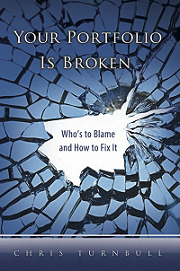Is your portfolio just a pile of parts?
Is there difference between a diversified portfolio and a collection of investments?
Advertisement
Is there difference between a diversified portfolio and a collection of investments?
 Is there difference between a diversified portfolio and a collection of investments? That’s an insightful question Chris Turnbull asks in his new book Your Portfolio is Broken: Who’s to Blame and How to Fix It.
Is there difference between a diversified portfolio and a collection of investments? That’s an insightful question Chris Turnbull asks in his new book Your Portfolio is Broken: Who’s to Blame and How to Fix It.
Turnbull is a portfolio manager with The Index House, an Edmonton wealth management firm. In his self-published book (available from Amazon), Turnbull explains that when he worked as a broker he would “recommend stocks, bonds, mutual funds, preferred shares, structured products, term deposits, new issues, and other types of securities, according to client preferences.” Often the clients would make their own suggestions, and those would end up in the portfolio, too. By the time he decided to end his career as a broker, his clients “collectively held 185 different mutual funds plus hundreds of stocks, bonds, and other securities.”
In other words, his clients didn’t have diversified portfolios: they simply had collections of investments. Turnbull uses an apt metaphor: “If, over many years, you acquired all the parts you thought you needed to assemble a car and you piled them up in your garage, would it be a car? Or just a pile of car parts?”
A diversified portfolio isn’t an ad hoc collection of investments: it’s designed and built to achieve a specific goal. For example, an investor might aim for long-term returns in the neighbourhood of 5% to 6%, with only a very small risk of losing more than 20% in any given year. Each asset in the portfolio should play a specific role: it should be there to increase the expected return or to lower the volatility. If it isn’t doing one of those two things, it should not be in the portfolio.
When you apply that rule, the number of assets you need in your portfolio shrinks dramatically. If you’re investing with index funds, it’s difficult to imagine a situation where you would need more than 10 asset classes in a portfolio. In fact, four to six funds will do at least 90% of the heavy lifting.
But how many people have such efficient portfolios? Certainly not clients of the investment salespeople I’ve encountered: their portfolios appear to be almost completely random. They’ll include a monthly income fund that holds the same stocks and bonds they own elsewhere. Plus there’s that sector fund that did well last year, and the specialty ETF that has a good yield. Oh, and a market-linked GIC that seemed like a good idea a couple of years ago. Top it all off with a sprinkling of individual stock picks from BNN, each one making up less than 1% of the portfolio so they’ll have no meaningful impact. It reminds me of a shopper who pushes a big cart around at Costco and just tosses in whatever looks interesting.
If your investments are a hodgepodge like this, it’s time for a different approach. Instead of collecting a pile of car parts, think about the car you want to build. How far do you need it to go? In other words, what is your required rate of return? How much time do you have to get there, and how fast are you willing to drive? (How much risk should you take?) And how much fuel are you putting in the tank? (What’s your savings rate?)
Only after answering those questions can you decide what components you needed to build a vehicle to those specifications.
Share this article Share on Facebook Share on Twitter Share on Linkedin Share on Reddit Share on Email